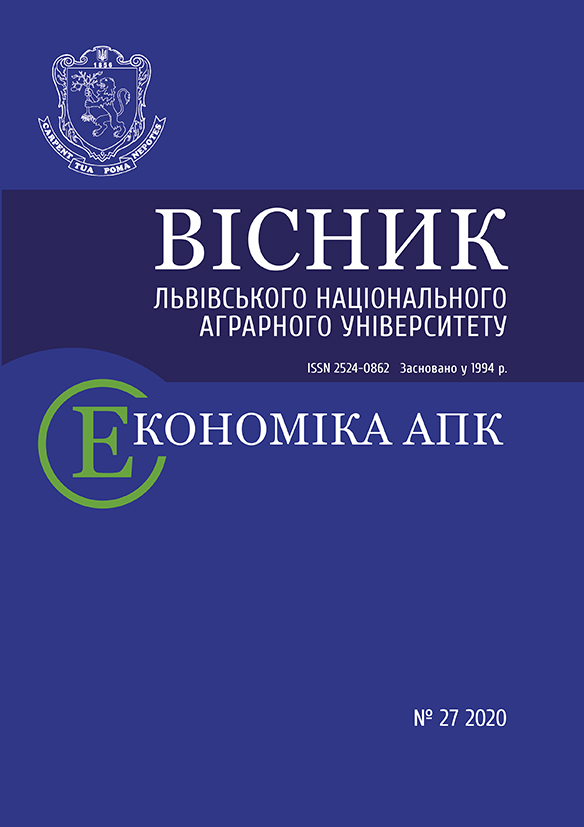Visnyk LNAU: Agronomy 2021 №25: 102-106
INFLUENCE OF A NEW COMPLEX MINERAL FERTILIZER NITROAMMOPHOSKA-M ON THE YIELDING CAPACITY AND QUALITY OF ROOT PARSLEY
Dydiv I., Candidate of Agricultural Sciences
ORCID ID: 0000-0001-8605-1092
Dydiv O., Candidate of Agricultural Sciences
ORCID ID: 0000-0003-4155-5945
Dydiv A., Candidate of Agricultural Sciences
ORCID ID: 0000-0002-4436-9008
Yuzkiv M., Lecturer
ORCID ID: 0000-0001-9904-7586
Lviv National Agrarian University
https://doi.org/10.31734/agronomy2021.01.102
Annotation
Parsley plants need a set of elements for their full growth and development. One of such fertilizers, which combines macro- and microelements, is the latest Ukrainian complex mineral fertilizer of prolonged action Nitroammophoska-M.
One used Nitroammophoska-M fertilizer in the form of water-soluble granules. The obtained research results confirm that when growing parsley on the ridges using the complex mineral fertilizer Nitroammophoska-M in the norm N72P144K176 provided the highest yielding capacity – 45.0 t/ha, which exceeded the control (without fertilizers) by 15.9 t/ha or 54.6 %. Application of Nitroammophoska-M in the norm N54P108K132 has supplied the yielding capacity of 43.9 t/ha, which is 1.1 t/ha less than the norm N72P144K176. Therefore, applying the increased rates of fertilizers (N72P144K176) there is a tendency to reduce the yielding capacity of parsley roots. The highest yielding capacity of marketable roots (93.5 and 93.7 %) was observed in the versions with application of the mineral fertilizer Nitroammophoska-M in the norms N36P72K88 and N54P108K132 kg/ha of a primary nitrient.
The complex mineral fertilizer Nitroammophoska-M improves the quality of parsley roots. Thus, it secured the highest content of dry matter (23.5 %) and total sugar (4.8 %) by applying fertilizers in the norm of N54P108K132. Using Nitroammophoska-M, the content of ascorbic acid varied from 21.5 mg/100 g (N54P108K132) to 18.6 mg/100 g (N72P144K176), remaining under control (without fertilizers) – 17.6 mg/100 g. The lowest content of nitrates in the control (134 mg/kg) was marked and in the version for the application of Nitroammophoska-M in the norm N18P36K44 (147 mg/kg), while for application of nitrogen fertilizers in the norm N60 (background) this figure was the highest – 209 mg/kg of wet weight. The content of nitrate nitrogen in all versions of the experiment did not exceed the maximum allowable concentration.
Key words
root parsley, Nitroammophoska-M, yielding capacity, marketability, quality, nitrates
Link
- Bolotskykh A. Encyclopedia of Vegetable Growers. Kharkiv: Folio, 2005. 799 p. (in Russian).
- Bondarenko H., Yakovenko K. Research Methods in Vegetable and Melon Growing. Kharkiv: Osnova, 2001. 369 p. (in Ukrainian).
- Vendylo H., Petrychenko V. Fertilization of Vegetable and Melon Crops on Small Property: Guide. Moscow: Agro-industrial Publishing House, 1990. P. 6˗9. (in Russian).
- Hospodarenko H. Fertilization of Garden Crops: Textbook. Kyiv: Limited Liability Company SIC GROUP Ukraine LLC, 2017. 340 p. (in Russian).
- Dydiv I. Economic and Biological Evaluation of Root Parsley Varieties. Breeding and Technological Innovations in Vegetable Growing, Reserves for Increasing Production and Seeds: abstracts of the International Scientific and Practical Conference of Young Scientists (July 25, 2013, Kharkiv). Kharkiv: Pleiades, 2013. P. 46–48. (in Ukrainian).
- Dydiv I., Dydiv O. Productivity of Root Parsley in the Western Forest-Steppe of Ukraine. Theoretical Foundations and Practical Aspects of Agro-Industrial Production and Rural Area Development: Proceedings of the International Scientific and Practical Forum (September 18–20, 2013, Lviv). Lviv, 2013. P. 79–81. (in Ukrainian).
- Dydiv I. Ridge Method of Growing Parsley as a Guarantee of High and Stable Yielding Capacity. Scientists of Lviv National Agrarian University in Production: Catalog of Innovative Developments. Issue 14. Lviv: Lviv National Agrarian University, 2014. P. 33. (in Ukrainian).
- Dospekhov B. Method of Field Experiment (with the Basics of Statistical Processing of Research Results). 5th Edition, added and revised. Moscow: Agro-industrial Publishing House, 1985. 351 p. (in Russian).
- Ketskalo V. Yielding Capacity of Root Parsley depending on Varietal Characteristics. Vegetable Growing in Ukraine: History, Traditions, Prospects: Proceedings of the International Scientific and Practical Conference dedicated to the 95th Anniversary of the Department of Vegetable Growing (September 21, 2016, Uman). Uman: Publishing and Printing House «VISAVI», 2016. P. 41–44. (in Ukrainian).
- Korniienko S., Honcharenko V., Khodieieva L. Fertilization of Vegetable and Melon Crops: Monograph. Vinnytsia: Limited Liability Company «Nilan-LTD», 2014. 172 p. (in Ukrainian).
- Sazonova L., Vlasova Ya. Root Plants: Carrots, Celery, Parsley, Parsnips, Small Radishes, Radishes. Leningrad: Agro-industrial Publishing House, 1990. 293 p. (in Russian).
- Nurzylnski J. Nawozenie roslin ogroddniczych. Lublin: Wydadawnictwo AR, 2013. 179 р. (in Polish).
- Sady W. Nawozenie warzyw polowych. Krakow: Plantpress, 2012. 267 р. (in Polish).



